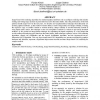Free Online Productivity Tools
i2Speak
i2Symbol
i2OCR
iTex2Img
iWeb2Print
iWeb2Shot
i2Type
iPdf2Split
iPdf2Merge
i2Bopomofo
i2Arabic
i2Style
i2Image
i2PDF
iLatex2Rtf
Sci2ools
WSCG
2004
2004
Rendering Techniques for Hardware-Accelerated Image-Based CSG
Image-based CSG rendering algorithms for standard graphics hardware rely on multipass rendering that includes reading and writing large amounts of pixel data from and to the frame buffer. Since the performance of this data path has hardly improved over the last years, we describe new implementation techniques that efficiently use modern graphics hardware. 1) The render-to-texture ability is used to temporarily store shape visibility, avoiding the expensive copy of z-buffer content to external memory. Shape visibility is encoded discretely instead of using depth values. Hence, the technique is also not susceptible to artifacts in contrast to previously described methods. 2) We present an image-based technique for calculating the depth complexity of a CSG shape that avoids reading and analyzing pixel data from the frame buffer. Both techniques optimize various CSG rendering algorithms, namely the Goldfeather and the layered Goldfeather algorithm, and the Sequenced-ConvexSubtraction (SCS...
| Added | 31 Oct 2010 |
| Updated | 31 Oct 2010 |
| Type | Conference |
| Year | 2004 |
| Where | WSCG |
| Authors | Florian Kirsch, Jürgen Döllner |
Comments (0)

